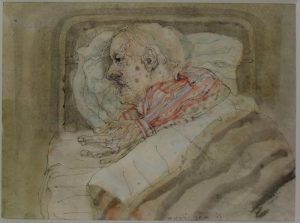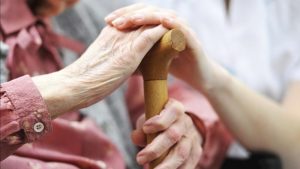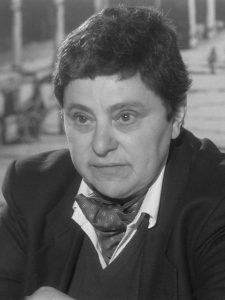An expected death at high age or another Corona death?
by
Erwin J.O. Kompanje, MD and Dr. Robert Gorter, MD, PhD.

There was a time when people died of old age. “Died of old age”. If someone had passed a certain age limit, death, as the end of life, was expected and in many cases even welcomed. The human body, like any organism, has an expiry date. It is slightly lower for men than for women, but on average most people die around the age of eighty. In the absence of dementia, physical aging goes hand in hand with mental maturation. Many old people in care homes and nursing homes do not strive for quantity, but quality. A different kind of quality than the pursuit of young people. Old people “no longer need to if necessary”, the career has long passed, many loved ones have already passed them in death, there is no longer a desire for material, dining in restaurants or traveling the world restlessly. In this phase of their lives, old people especially want frequent contact with others, preferably with their dear children, grandchildren, and great-grandchildren.
In many nursing homes and nursing homes, the man with the scythe is waiting in the recreation room for his next customer. And when the elderly person becomes aware of this death announcer, there is remarkably rare resistance, but mostly resignation. It has been good for most elderly people. Above the death reports in the newspapers is usually “After a well-spent life”; “Quietly slipped into death”; “In Alzheimer’s, she has passed into the light.” Rarely there is a struggle, rarely resistance, always resignation, often relief, but there is also a sweet lack of memory in the relatives but acceptance.
The man with the scythe is remarkably often a bit helped in old people. The flu, pneumonia (“Friend of the aged” as William Osler called it), a fatal stroke give many the final inevitable push over the edge of lived life in the inevitable death.
In the last few weeks, the natural, expected “death from old age” has suddenly changed in many cases. Now, this is called “Death by corona” and the deceased elderly are suddenly called “Corona victims”. A deceased elderly person is suddenly a figure in the daily roaring update of RIVM. These figures make an impression in society. “Regret 130 Corona victims again.” “Fortunately fewer Corona deaths today.” Is this the “new normal”, a term where I start to get some increasing itching.
After all, there is no difference between death from the coronavirus and other inevitable final moves such as influenza or banal pneumonia. They are all in the last phase of life, almost always the same and doctors and carers in the first line expect these last moves and, in consultation with the old sick and his neighbors, in most cases accept this as the end of earthly existence and directly don’t take them to hospitals. After all, that does not serve a purpose in most cases.
Before the Corona crisis, no newspaper kept a list of how many elderly people died daily from influenza or banal pneumonia. Last week it was reported in the newspapers that “CBS saw hundreds of more corona deaths that RIVM” Reports said that nine out of ten of these deaths were aged 65 years. However, Statistics Netherlands’ statistics show that these are mainly elderly people aged 80 or more. It was unexpected excess mortality. Very normal during a wandering virus, like every year during the time of influenza. For many, it has not been established that infection with the coronavirus was the last push, but this is the big suspect. The media did not hesitate to draw attention to this widely. After all, the corona disaster was even bigger than we thought. The number of deaths was probably twice as high. I suspect many sensible physicians would have accepted end-of-life death as normal and foreseeable death without testing. It serves no purpose to know which virus or bacteria caused fatal pneumonia. Not even at a time when corona seems to rule all of life. Another message: “More than fifty corona deaths in Rotterdam nursing homes.” Half of the demented elderly in one ward died. If these elderly people with dementia had died of influenza, as happens every year during the seasonal flu, then I wonder if that had made the newspaper. It is good to realize that in the winter of 2017-2018 an estimated between 9,000 and 10,000 people in the Netherlands died of infection with the influenza virus. In most cases, these were also elderly people which was to be expected.
We live in an illusion of immortality. Especially in a time of corona. We do not want and cannot accept that old people die in the final stages of life. What they die too? That does not matter. After all, it was to be expected. But, very striking, not in the time of corona. The Healthcare and Youth Inspectorate (sic) will investigate deaths in the Rotterdam nursing home De Leeuwenhoek where fifteen elderly people with dementia have died, presumably from the coronavirus, but it could also be influenza. Minister De Jonge stated during the Council of Ministers: “The signals about this location are of course serious enough to want to know: what is going on here?”. Did the inspectorate also investigate the thousands of influenza deaths in the winter of 2017-2018? Was it also the subject of the Council of Ministers? What is going on? This: End-of-life old people die from a fatal infection from a virus or bacteria. As it has been for many hundreds of years, year after year.
To prevent the elderly from dying from the coronavirus (or other virus or bacterial respiratory infection), they are now suddenly isolated. It is precisely what they still experience quality in their last phase of life that they are now resolutely and without their participation. Social interaction with their loved ones must be done digitally via Skype or behind the glass. Grandchildren should no longer be cuddled, no longer touched, no longer allowed to visit, the children of the elderly should no longer be allowed to visit, kiss or hug them. I saw menacing red and white ribbons strung around a nursing home in my hometown: a place not to be. Physical communication has suddenly become a taboo, while contact with the elderly is so important. Social distancing and isolation are terrible for the elderly. It is called skin hunger, the harmful lack of physical contact. One and a half meter (and more) distance will be fatal for many because they desolate in isolation. People with dementia will not understand why their loved ones no longer visit. A humanitarian catastrophe is currently striving to keep the number of corona deaths as low as possible. Understand me, every death of a loved one is an amputation for the next of kin, but in the last phase of life, it is something we can prepare for. Immortality is an illusion. We need to be much more aware of this and let us not process a person who dies in old age cold statistically as a “corona death” but as a natural and expected death after a long life. Above the obituary it should be written: “After a well-spent life quietly dies in old age”, but let that death take place for basic humanitarian reasons in the presence of those who still matter to the older person. I was reminded of the beautiful song by Claudia de Breij “May I have it with you”. She ends with:
When the end comes
And if I am afraid
Can I come to you then?
When the end comes
And when I’m alone
Can I come to you then?
Are we going to remember these people?

Dr. Robert Gorter:
And then the new discussion starts, which is a very new one in Northern Europe: how long can an elderly person live? How long is it economically still acceptable? It is thought in economic terms: someone who is 70 or older is no longer so productive and is going to “cost more and more money.” For this reason, groups of doctors, economists and politicians are seriously discussing whether the money for operations or expensive medicines is still well spent on the elderly above the age of 70. There are even politicians who would like to have euthanasia performed “elegantly” in the elderly above the age of 72. Only the word “euthanasia” is not so-called, but all proposals to deny the elderly, who are sick, medical and social care so that they die faster, is the heritage of euthanasia.
And then the problem of elderly people with dementia: there is a very intensive discussion here. How much is the life of a demented elderly person still worth? A syringe can still quickly and painlessly relieve suffering (as with an old dog, who lets you “fall asleep”).
This phenomenon (applying euthanasia), which used to be embarrassing to think or talk about, is now very modern and no longer taboo among most Dutch people. Yet it had been foreseeable. Andreas Burnier had already paid attention to it in the eighties: when it was about abortion provocateurs and she warned about the “Slipping Slope” because an unborn human was increasingly seen as a lump of meat that only after a pregnancy of First becomes human 9 months at birth.
In the eighties of the last century, a limit for a medical abortion of 8 to 12 weeks of pregnancy was set. There are several states in the USA that now support abortion up to 9 months of pregnancy. And Andreas Burnier, in particular, had warned strongly about this and also substantiated that. And Andreas repeatedly said (as an anthroposophist) that birth is through the two gates through which we all (alone) go. And if one starts to rumble at the gate of birth, then it is irrevocably also the gate of death: the slippery slope (slippery slope).

Andreas Burnier, pseudonym of Catharina Irma Dessau, (The Hague, July 3, 1931 – Amsterdam, September 18, 2002) was a Dutch writer. Under her name, she was a professor of criminology at the Catholic University of Nijmegen from 1973 to 1988.
Dessau was born in 1931 in the Bethlehem clinic in The Hague. She was the oldest child in a liberal Jewish family. During World War II, she went into hiding for three years (1942-1945) at constantly changing addresses and separated from her parents for security reasons. During the hiding period, she used the pseudonym Ronnie van Dijk. She would keep using the first name Ronnie all her life. She lived in the Achterhoek, Drenthe and the Veluwe, where she spent the last months with her father. She went to Amsterdam with him after the war.
After the war, she attended the Vrijzinnig-Christelijk Lyceum in The Hague and then studied medicine and philosophy in Amsterdam. She was unable to complete this study because a professor did not take her seriously as a young girl and refused to accompany her.
At the age of twenty-two (September 1, 1953) she married publisher J.E. Zeijlmans van Emmichoven (Emanuel, nickname Gabriel), with whom she had two children. At the same time, she learned anthroposophy through him and especially through his parents. Especially through her father-in-law F. W. Zeylmans van Emmichoven, Rudolf Steiner’s different views influenced her later publications. They divorced in 1961 and Dessaur resumed her studies. She graduated cum laude in social sciences and obtained her Ph.D. in social criminology in Leiden.
She made her debut in Tirade in 1965 and in the same year her first novel A satisfied smile was published. Burnier, who came out as a lesbian after her divorce, had taken her experiences as a starting point for this novel as a starting point. She was the first author in Dutch-language literature to write in a completely self-evident way about female homosexuality and this theme also plays an important role in her later novels. Burnier wrote about women’s love and lived with a woman when that was completely taboo and therefore, like Gerard Reve, meant a lot for the emancipation of gays. Burnier also wrote in The Boy Hour about her transgender feelings: in this book, which she says is one of her most autobiographical books, the female protagonist Simone would rather be a boy.
Also, she was an important forerunner of the Second Feminist wave in the late 1960s. When Dolle Mina was yet to be founded, Burnier already wrote about the accident of being born in a female body and being considered second-rate and despised. Her feminist views were radical and she was dissatisfied with the way the women’s movement was fighting. In her eyes, it was a lamentation, which swiftly demanded to swell in self-pity, without showing initiative and ambition itself. It also annoyed her that – in the then-popular neo-Marxist jargon – the individual was not held responsible, but that the structures were blamed consistently. Her “sisters” did not thank her for this negative attitude towards the women’s movement.
Burnier has felt oppressed from an early age – as a woman, (latent) homosexual and as a Jew – and that was her main source of inspiration. She once said herself: “It is always a privilege to be born into an oppressed group. It is much more difficult for someone who belongs to the ruling caste … to ever gain any insight. “Suffering is good for people,” said the (former) Russians. It is good in the sense that it keeps you awake, sharpens your awareness, stimulates your mental activity. ”
In addition to novels, Burnier published essays, letters, and articles, initiating important social debates and she was also regularly the center of violent controversies. In addition to the emancipation of homosexuals and feminism, she drew attention to human dignity and opposed euthanasia, provocation abortion, and genetic engineering. Just when a majority emerged in the Netherlands in the 1980s that wanted to legalize euthanasia, Burnier opposed this. In doing so, she compared euthanasia with Nazi practices and asked questions such as how ‘voluntary’ is euthanasia for the very elderly, who consider themselves a burden on their environment if doctors and family offer it as a good ‘solution’? Why kill when good pain relief is possible? Who decides when a life is worth living? Where is the limit of ‘full-fledged’ life? An avalanche of criticism, anger, and scorn was her part.
As a result of her experiences in the war, Burnier did not want to know anything about religious Judaism for a long time. The protagonists in her novels are rarely Jewish. It was only at the end of her life that she came to terms with her religious background and this theme is central in her latest novel The World of Glass (1997).
Decatur died unexpectedly at the age of 71 from a cerebral hemorrhage and was buried in silence at the Liberal Jewish Cemetery Gan Hasjalom in Hoofddorp. At the time, none of her work was busy. Tilly Hermans of Augustus publishing house decided to republish Burnier’s most important work. A collection was compiled with a choice of essays and letters and large interviews with the writer. At the same time, three of Burnier’s novels appeared in one volume: Boy’s Hour (1969), The Literary Salon (1984) and The Train to Tarascon (1986).
Dr. Gorter:
Andreas Burnier and I became very good friends and Andreas stayed with her life partner till her sudden death, Tieneke van Mourik at my home in San Francisco, California for a while, while teaching and conducting clinical research as a professor at the University of California San Francisco Medical School (UCSF). She was able to write essays and a book in peace. I remember very well our lively conversations in San Francisco.
Why do I worry about our culture and our society? Because I witness the “slippery slope” as remarkably described in detail by Andreas Burnier (and Rudolf Steiner 1961-1925). Already in the early 20th century, Rudolf Steiner described in great detail in his books, writings and lectures: and also why; and that makes Rudolf Steiner extra interesting.
Then about seeing people exclusively as an economic unit …. about that another time …..